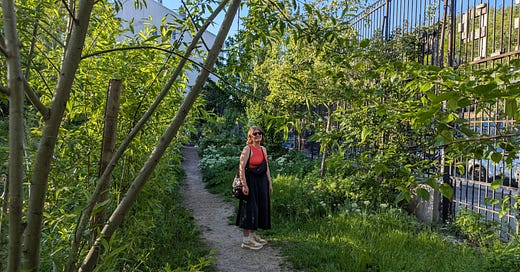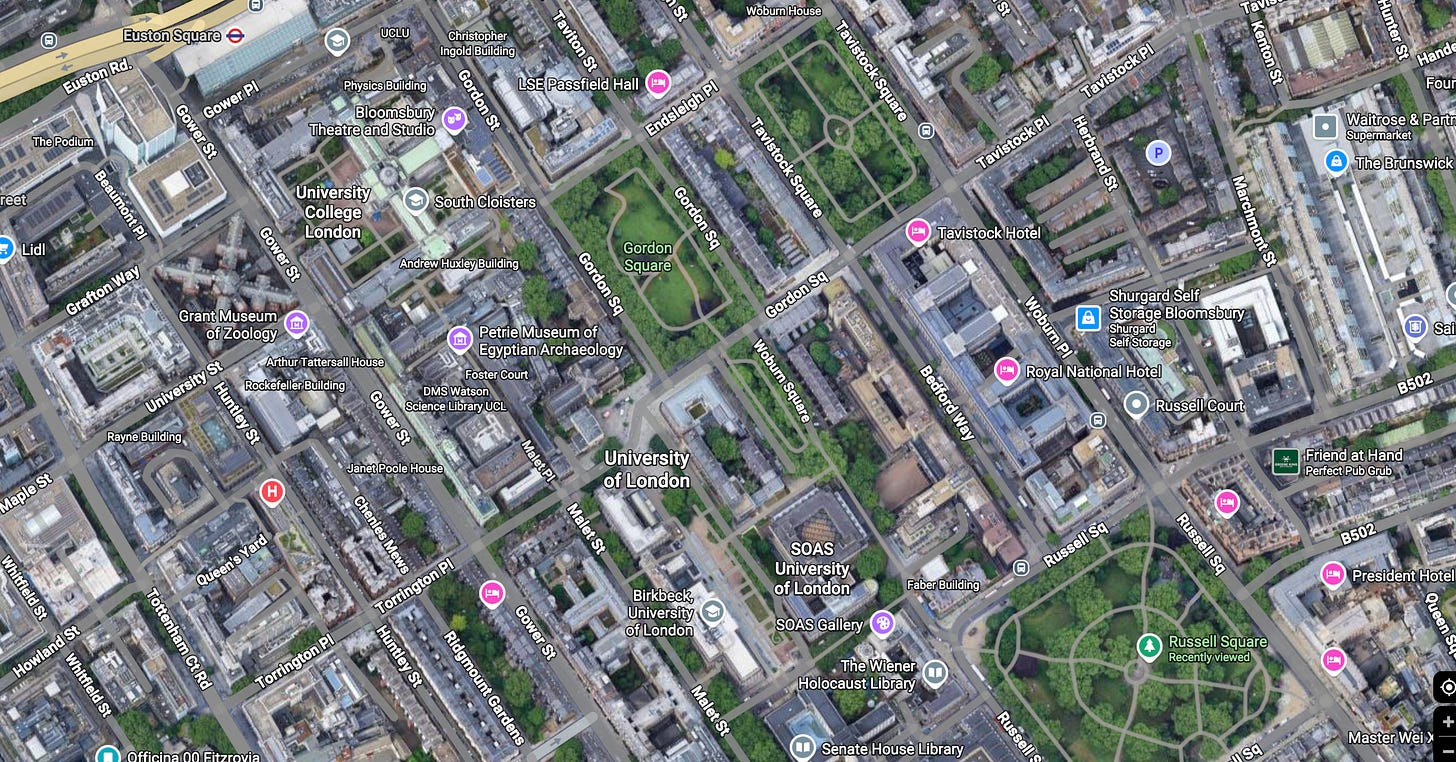Last month I spent a few days in Paris with my partner. It’ll be no surprise to you that when I travel, my priorities are usually seeking out good food and drink, plus a good old dose of nature. But in more recent years I have come to realise that ‘nature’ is all around us (and, of course, that humans are part of nature too). Now, when I travel to a new city, I tend to just ‘see what I see’ in terms of nature, rather than planning loads of specific trips to parks, rivers, lakes or botanical gardens. I find this gives me a better sense of what a city has to offer, and since becoming a London National Park City Ranger in 2022, I’m particularly intrigued to find out what I naturally stumble across while I’m traveling.
In Sheffield, I was impressed by the street planters filled with wildflowers and native species, plus well thought-out insect nesting places and signs about planting schemes.
In Newcastle and Gateshead I enjoyed watching (and listening to) the many kittiwakes nesting on bridges, shop fronts and the Baltic gallery.
In Edinburgh, I was dazzled by gorse on the way up Arthur’s Seat and impressed by the Meadows Community Garden.
In Paris I was greeted by swifts, so of course I was instantly smitten. Another community space, called La TEP Ménilmontant, was a haven for nature (including people!) in the 11th arrondissement, one of the most densely populated urban districts of any European city. There were chickens being well tended to, a tucked away nature reserve, community compost heaps and many people enjoying the games and quiet seats on offer.
I was also utterly charmed by Parc Clichy-Batignolles – Martin Luther King, where cooing at greylag goslings and moorhen chicks was just as enjoyable as watching the many Parisians soaking up the sun. Much to my excitement, there was also a water bottle refill station offering a choice of still or sparkling!
Sunshine helped…. People-watching is always fun in Paris, but the park was buzzing on the sunny bank holiday afternoon we visited.
I love the way cities come alive in the sunshine. After a night out in late March, I nursed a hangover by wandering through sunny green squares in Central London - watching people stop to photograph the cherry blossom or read quietly under the shade of a plane tree felt like bliss. Even the child shouting loudly while chasing bubbles somehow distracted me from my headache.
Whether it was playtime with my dog and brother when I was little, reckless teenage drinking sessions with my friends, or jogs to help clear my head in my 20s, urban parks and green spaces played a big role in my life, growing up in South London.
I may not have known what they were called at the time, but I was totally enamoured with the white poplars in my local park when I had a foster dog named Scooty, who also endured a cherry blossom photoshoot in my meagre attempt to find her a ‘forever home’. Colourful flowers outside a local cemetery and the many ring-necked parakeets that roosted there helped me find positives when I was unhappy in my living situation. One of my favourite memories is running with my mum, along the river at the end of the road I grew up on. Mum, who had since moved to Scotland, but used to run along the same stretch of river most days, asked: “Do you ever see kingfishers along here?” and before I could utter the word “no”, a bright flash of blue zoomed past us - magic!
I was inspired to become a London National Park City Ranger after a friend of mine visited from Liverpool and said she didn’t think that London was “very green”. I was astounded! I figured she just didn’t know where to look. So I made it my mission to help others find the many green spaces London has to offer, and to notice the not-so-obviously-green (like lichen on walls, volunteer plants growing through the cracks in the pavement or the swifts soaring overhead).
Along with a small group of passionate nature lovers, in 2023 I set up Wild South London, a community group which helps people explore their local green spaces and discover the brilliant biodiversity on their doorsteps. Over the past couple of years it’s been a pleasure to witness people learn more about the natural world, and I’ve learnt so much along the way too.
On Saturday 28th June, thanks to funding from London National Park City, we’re hosting a Midsummer Nature Festival in Beckenham Place Park, one of my favourite places in the world. It’s where many of my early experiences with woodland were and I have many happy memories of walking my dog in the park as a child. During the pandemic, the park was my haven (once my anxieties over how much busier it had become eased) and was fundamental to maintaining my mental health. So any time I get to share it with other people, and introduce people to its wonders, I’m happy.
Wild South London’s Midsummer Nature Festival is part of Beckenham Place Mansion’s series of Open Doors events, so we’ll mostly be bringing the natural world inside on this occasion, but Butterfly Conservation Youth Panellist Şeniz Mustafa is hosting a butterfly walk at 1pm (book free tickets here) and the Wild South London team have created a nature trail to help children (and big kids) discover some of the species that can be found in the park. I highly recommend exploring the park before and after the event too - particularly the ancient woodland. Inside the mansion, you can learn more about butterflies from Şeniz, who has designed a fact-finding activity, make zines exploring the future of the park, discover more about midsummer traditions, create hapa zome prints with Happy Wild Ones forest school, make herbal smoke sticks with The Bromley Forager, do some colouring in, add to our Midsummer Sun artwork and more! Drop in any time between 12:30 and 4:30pm and find out more here. I’d love to share the magic of South London with you.
Your task this week is to visit a city park! If you don’t live near a city, perhaps you can visit your closest urban area and see what you stumble across, or make plans to visit a new city in the future.
Story from issue 38 of The Happy Newspaper (of which I am the editor)
Further Reading
Download the 2025 London National Park City Paper, which I edited. 12 Ways to Connect People & Nature in London is LNPC’s second print publication and contains 52 pages packed full of inspiration, inspired by the Foundation’s charter point: Lives, Health and Wellbeing.
Find out more about Wild South London and become a member for just £10 a year. We are a not-for-profit community group and we rely on memberships, donations and occasional funding to keep doing the work we do. That being said, we do not want money to be a barrier to becoming a member, so please contact us if you would like to become a Wild South London member but would struggle to pay the fee.
The Secret Life of a Cemetery: The Wild Nature and Enchanting Lore of Pere-Lachaise by Benot Gallot is a lovely little book about a famous cemetery in Paris (sent to me by its publisher, Greystone Books). Pere-Lachaise is right opposite La TEP Ménilmontant, which I mentioned in this post. I only spent a very short amount of time there (I was carrying a very heavy backpack) but I was so impressed by the way nature had been managed - or not managed - there as I walked through. This book arrived at my house about a week after I returned and now I’m desperate to hop on the Eurostar again and explore soome more.
The Edible City: A Year of Wild Food by John Rensten was my first foraging book and helped me discover such joys as garlic mustard while exploring Beckenham Place Parks.
The Stubborn Light of Things is complied from Melissa Harrison’s Nature Notebook column in The Times and outlines her interactions with the natural world in both London and rural Suffolk.
Got any other city nature book recommendations? Share them in the comments!
Disclosure: If you buy books linked to this Substack, I may earn a tiny commission from Bookshop.org, whose fees support independent bookshops















Memories...are made by kingfishers! x
Ooh I was enjoying this piece even before I saw you'd mentioned my book! Thank you!